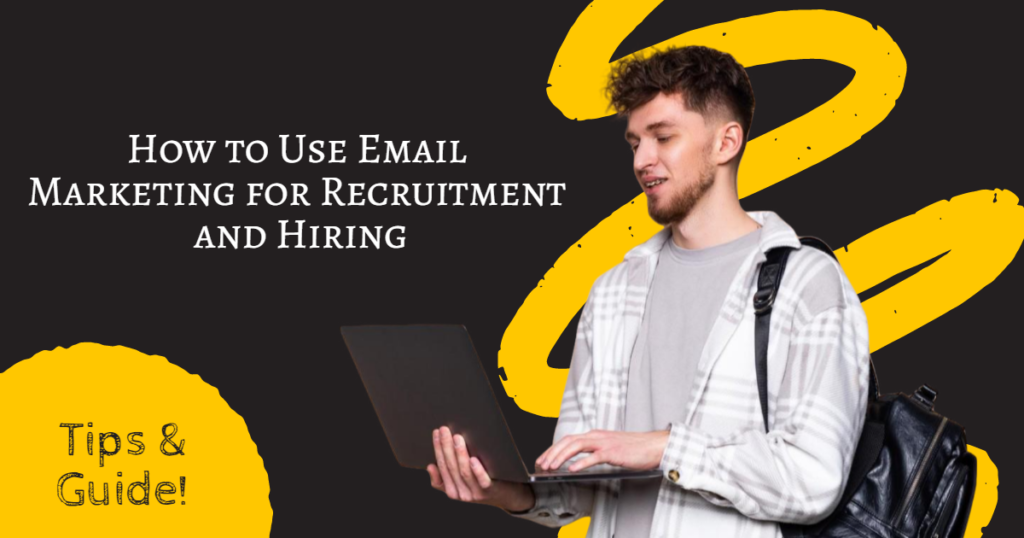Emails are a powerful tool for reaching out to potential candidates, even in today’s world of multiple recruitment options. When utilized effectively, recruiters can establish communication and monitor the candidate’s journey through the hiring process.
Email marketing offers two major advantages for the recruitment industry:
By maintaining consistent communication via emails, you increase the likelihood of being remembered when a candidate begins job searching. Regular newsletters and valuable content will create a lasting impression and increase the chances of them reaching out to you.
By sending a weekly or bi-weekly newsletter that features helpful articles and job listings relevant to the subscriber’s industry, you can establish authority and position yourself as an expert in the field. This can help sway undecided candidates to take the next step.
That’s why 85% of recruiters consider email marketing to be their preferred method of building relationships with candidates.
Now that we understand the effectiveness of email marketing for recruitment and hiring, let’s explore how to effectively recruiting emails.
Establish a Trustworthy Email List
The success of an email campaign heavily depends on the engagement of subscribers on your email list. To obtain prospects who will actively engage with your emails, you can utilize various lead generation techniques such as:
- Offering a sign-up incentive
- Providing a free resource for download
- Registering for a free webinar
When your prospects sign up, it demonstrates their interest in receiving emails from you. Furthermore, by asking about their preferences during the sign-up process, you can gather relevant information on what the candidate is searching for.
Target Your Audience and Segment Them Appropriately
Now that you have attracted your desired audience to your email list, it’s time to deliver on your promise and send them relevant emails. This starts with identifying your audience and the purpose of your email campaigns.
Consider their current job profile and industry, and determine if you need to inform them about job openings or educate them about your services. Once you have established your target audience and set clear goals for your email campaigns, it’s time to segment your audience.
Segmenting your email list involves dividing your current email list into smaller groups based on a common trait, such as:
- Job title
- Industry
- Experience level
- Location
- Activity level
By segmenting your email audience into smaller niches, you have a higher chance of providing them with tailor-made content, which can significantly reduce unsubscribe rates and increase open rates.
Incorporate Personalization
While segmentation allows you to send custom content, you can take it one step further by incorporating personalized content that feels more personal, as if written specifically for them. Start by addressing your subscriber by their first name, and then further personalize based on their interactions with your emails.
For example, you can send birthday greetings on their birthday, or based on the skills they have specified on their resume, you can send links to relevant content for skill building. You can also suggest jobs based on the educational institutions they have attended and chosen by their peers.
By sending personalized content via email, you demonstrate that you value them as individuals and not just names on a list, helping you build meaningful relationships with candidates.
Lead them to a clear and actionable call-to-action
Regardless of the purpose of your email campaign, it’s crucial for your email content to engage your subscribers and guide them towards a clear and actionable call-to-action. This could be anything from updating their profile, reading an informative article, or downloading a resource that you’re offering.
Your email template design will determine whether the call-to-action is a button that subscribers can click on to be redirected to the relevant page, or a simple plain-text link. What’s most important is that the call-to-action language should be direct and encourage action. Instead of using generic terms, use conversational language such as “Download your copy,” or “Update my profile.”
For example, Litmus, an email marketing agency, created an email listing available positions with a call-to-action of “Find Your Dream Job.” This call-to-action is clear and actionable.
Create Attention-Grabbing Subject Lines
The first thing your subscribers see when they receive an email is the subject line. It is crucial for the subject line to clearly indicate what the email is about, as this can influence whether the recipient decides to open the email or ignore it. To capture the reader’s attention, it’s important to craft a subject line that is both short and intriguing.
Ensure Mobile Optimization and Readability
With the increasing use of mobile devices to check emails, it’s crucial to make sure that your email templates are optimized for mobile viewing. The subject line should be concise enough to fit within the standard view of a mobile device, the call-to-action button should be big enough to be tapped with a thumb, and the font size should be large enough to be readable from a distance.
Additionally, people tend to quickly scan through their emails, usually spending only 12 to 15 seconds on each one. To make it easy for your subscribers to grasp the important information, format your email copy in a scannable manner. You can use paragraphs, different colors, or bullet points to break down the information.
Use automated emails for reminding schedules or interviews.
Automated emails can be a game-changer for many organizations. By programming emails to automatically send when specific conditions are met, you can effortlessly send reminders for scheduled appointments or job interviews to your candidates. Additionally, you can also use this feature to regularly send newsletters tailored to your candidates’ interests.
In conclusion, email marketing is a straightforward and manageable tool. It just requires some time to become familiar with its various features and capabilities. Once you have mastered the art of sending relevant emails and keeping up with regular follow-ups, you can effectively handle your recruitment and hiring process through email alone.”

